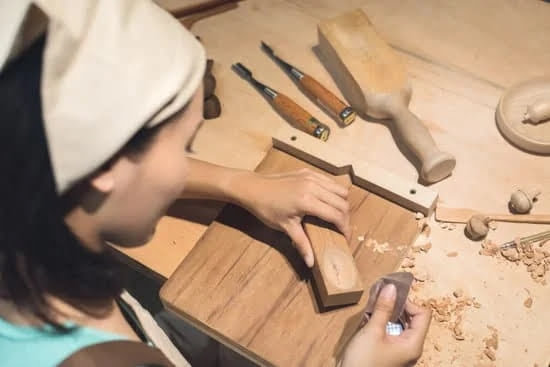Are you a woodworker looking for the perfect work table to enhance your projects? In this article, we will guide you through the process of building your very own woodworker work table. From choosing the right materials to adding finishing touches, we will provide you with all the information you need to construct a durable and functional table for your woodworking needs.
A sturdy and reliable work table is an essential component of any woodworking shop. It provides a stable surface for cutting, sanding, and assembling your projects, while also offering storage space for your tools and materials. Whether you are a beginner or an experienced woodworker, building your own work table allows you to customize it to fit your exact specifications and preferences.
Before diving into the step-by-step guide of constructing a woodworker work table, it’s essential to familiarize yourself with the tools and materials needed for this project. Choosing the right type of wood is also crucial in ensuring that your work table is not only sturdy but also visually appealing. So let’s get started on creating the perfect work table for all your woodworking endeavors.
Tools and Materials Needed for Building a Woodworker Work Table
When it comes to building a woodworker work table, having the right tools and materials is essential for ensuring a successful project. Whether you are an experienced woodworker or a beginner looking to embark on your first DIY furniture project, having the appropriate items on hand will make the process smoother and more enjoyable.
Essential Tools
Before getting started, gather these essential tools: a circular saw or table saw, a power drill with driver bits, a tape measure, a framing square, clamps (bar clamps and spring clamps), wood glue, and safety gear such as goggles and gloves. Additionally, having a level and carpenter’s pencil will aid in achieving accurate measurements and markings during the construction process.
Materials
In terms of materials, you will need lumber for the frame and tabletop, plywood for the shelves (if desired), screws or nails for assembly, wood stain or paint for finishing, as well as sandpaper for smoothing any rough edges. Depending on your design preferences, you may also want to consider adding casters or wheels to make your work table mobile.
Optional Tools
While not necessarily required, investing in some optional tools could make the building process easier. These include a pocket hole jig for concealed joints, a router for decorative edging on the tabletop, and a doweling jig for creating strong joints without using metal fasteners.
By gathering these tools and materials before starting your project, you’ll be well-prepared to tackle each step of building your woodworker work table with confidence.
Choosing the Right Wood for Your Work Table
One of the most important steps in building a woodworker work table is choosing the right type of wood. The wood you select will significantly impact the durability, stability, and overall performance of your work table. When selecting wood for your project, consider factors such as strength, hardness, resistance to wear and tear, and the overall aesthetic appeal.
The most commonly used types of wood for work tables are hardwoods such as oak, maple, cherry, and birch. These woods are known for their durability and ability to withstand heavy use. Softwoods like pine or cedar can also be used but may require more maintenance over time. It’s important to select a wood that fits your specific needs and preferences.
Additionally, when choosing wood for your work table, consider the grain pattern and color variations in the wood. These characteristics can add visual interest to your table and enhance its overall appearance. Once you have chosen the type of wood for your work table, it’s essential to properly prepare the lumber by sanding it down and applying a finish to protect it from moisture and other elements.
Relevant Data
| Type of Wood | Characteristics |
|---|---|
| Oak | Durable with prominent grain patterns |
| Maple | Hardwood known for strength and resilience |
| Pine | Softwood that requires more maintenance but offers a unique look |
Step-by-Step Guide to Constructing the Frame of the Work Table
Building the frame of your woodworker work table is a crucial step in the construction process. The frame provides the structure and stability needed to withstand heavy-duty projects and everyday use. Here’s a step-by-step guide on how to build the frame for your work table:
1. Measure and Cut the Wood: Start by measuring and cutting the wood pieces according to your desired dimensions for the work table. Use a sawhorse or a stable surface to support the wood as you cut.
2. Assemble the Legs: Take four of the cut pieces to serve as the legs of your work table. Position them vertically on a flat surface and use clamps to hold them in place. Then, drill pilot holes and insert screws to secure them together.
3. Connect the Sides: Next, take two long pieces of wood to serve as the front and back sides of your work table. Position them horizontally between the legs, ensuring they are level and even. Drill pilot holes at each connection point before securing with screws.
4. Reinforce with Braces: To add extra support and stability, install braces at each corner where the legs meet the sides of the table frame. This will help prevent wobbling or shifting during use.
By following these steps, you can build a sturdy and reliable frame for your woodworker work table that will provide the foundation for all of your future woodworking projects.
Now that you have successfully constructed the frame of your work table, it’s time to move on to adding the tabletop and shelves. These components will further enhance the functionality and versatility of your work table, providing ample space for various tools, materials, and projects. Read on for tips and techniques on adding these essential elements to complete your woodworker work table.
Adding the Tabletop and Shelves
Building the tabletop and shelves for your woodworker work table is a crucial part of the construction process. This section will provide you with tips and techniques to ensure that these components are sturdy, functional, and visually appealing.
Choosing the Right Materials
When it comes to constructing the tabletop and shelves, it’s important to select durable and high-quality materials that can withstand the demands of woodworking projects. Hardwoods such as oak, maple, or birch are excellent choices for tabletops due to their strength and resistance to wear and tear. For shelves, consider using plywood or MDF (medium-density fiberboard) for added stability. Additionally, be sure to measure and cut your materials accurately to achieve a precise fit.
Joinery Techniques
To secure the tabletop and shelves to the frame of your work table, you’ll need to utilize effective joinery techniques. Traditional methods such as mortise-and-tenon joints or dovetail joints are popular options for creating strong connections between wood pieces.
Another option is using pocket hole joinery, which involves drilling angled holes into one piece of wood and then joining it to another piece with screws. Whichever technique you choose, make sure that the connections are tight and secure.
Adding Finishing Touches
Once the tabletop and shelves are securely attached to the frame, it’s time to add finishing touches to enhance their appearance. Sanding down any rough edges or uneven surfaces will create a smooth finish that is safe for handling wood materials. Applying a stain or sealant will not only protect the wood from moisture and damage but also beautify its natural grain patterns. Consider using a polyurethane varnish for added durability against scratches and spills.
By following these tips and techniques for adding the tabletop and shelves to your woodworker work table, you can ensure that your construction project is successful in both form and function.
Finishing Touches
After constructing the frame of your woodworker work table, it’s time to add the finishing touches that will not only enhance its appearance but also improve its durability. The sanding, staining, and sealing process is crucial in bringing out the natural beauty of the wood while protecting it from wear and tear. Here’s a step-by-step guide on how to achieve a professional finish for your work table:
1. Sanding: Start by sanding the entire surface of the table using a coarse grit sandpaper to remove any rough spots or imperfections. Gradually work your way up to a finer grit sandpaper until the surface feels smooth to the touch. Be sure to sand with the grain of the wood to avoid any scratches.
2. Staining: Once the surface is prepped and smooth, apply your chosen wood stain evenly with a brush or rag, following the manufacturer’s instructions for drying time and application techniques. Allow the stain to penetrate the wood for a few minutes before wiping off any excess with a clean cloth. For a darker color, apply multiple coats as needed.
3. Sealing: To protect your work table from moisture, stains, and daily use, it’s essential to seal it with a clear polyurethane or lacquer finish. Apply two to three coats of sealer, allowing each coat to dry completely before sanding lightly between coats for a smooth finish.
By following these steps and taking your time during each stage, you can achieve a beautiful and durable finish for your woodworker work table that will last for years to come.
4 Easy Steps for Sanding Your Work Table:
Tips for Applying Wood Stain:
Sealing Your Work Table for Protection:
Customizing Your Work Table
Now that you have successfully built the frame, tabletop, and shelves of your woodworker work table, it’s time to consider adding some optional features and add-ons to make it even more functional and convenient for your specific needs. Whether you’re looking to enhance its storage capacity, improve its mobility, or incorporate specialized tools and accessories into the design, there are plenty of customizable options to consider.
Here are a few optional features and add-ons to consider for customizing your woodworker work table:
- Casters or wheels: Adding casters to the bottom of your work table can make it easier to move around your workshop. This is especially useful if you have limited space and need to reposition your table frequently.
- Tool storage solutions: Consider incorporating built-in storage compartments, drawers, or racks for organizing and storing your woodworking tools. This can help keep your workspace tidy and maximize efficiency during projects.
- Power outlets and lighting: If you often use power tools or need ample lighting while working on projects, you may want to install power outlets or LED strips directly onto the table. This can eliminate the need for extension cords and provide better visibility in your workspace.
- Clamping systems: Explore adding clamping systems such as bench dogs, holdfasts, or vises to secure your workpieces in place while cutting, sanding, or assembling. These features can greatly improve the accuracy and precision of your woodworking tasks.
As you customize your woodworker work table with these optional features and add-ons, remember that the goal is to tailor the design to suit your specific needs and workflow. Take the time to assess how these enhancements can benefit your woodworking projects and make adjustments as necessary during the customization process.
By incorporating these optional features into your work table design, you can create a versatile and personalized workspace that enhances both the functionality and efficiency of your woodworking endeavors.
Maintaining and Caring for Your Woodworker Work Table
Once you have built your woodworker work table, it is important to properly maintain and care for it in order to ensure its longevity and continued functionality. Proper maintenance will also help preserve the aesthetic appeal of the table and protect it from wear and tear over time. By following a few simple steps, you can keep your work table in top condition for years to come.
One important aspect of maintaining your woodworker work table is keeping it clean. Regularly remove any sawdust, wood shavings, or other debris from the surface and shelves of the table to prevent buildup that could potentially damage the wood or affect the stability of the table.
Using a soft brush or a vacuum with a brush attachment can help with this process. Additionally, wiping down the table with a damp cloth after each use can help prevent dust from settling into the wood grain.
Another key component of caring for your work table is ensuring that it remains level and stable. Over time, the table may experience slight shifts or movements that can affect its overall balance.
Periodically check the levelness of the table using a carpenter’s level and adjust the feet or base as needed to maintain stability. This will not only ensure safety while using power tools and machinery on the table but will also prevent any warping or damage to the structure over time.
In addition to regular cleaning and maintenance, applying a fresh coat of protective finish every year can help prolong the life of your woodworker work table. This can include sanding down any rough spots or scratches on the surface before reapplying an appropriate sealant or stain to protect the wood from moisture, heat, and other potential sources of damage. Taking these proactive measures will keep your work table looking great and functioning effectively for many years.
Conclusion
In conclusion, building your own woodworker work table can be a rewarding and fulfilling experience. Not only does it allow you to customize the table to fit your specific needs and preferences, but it also gives you a sense of accomplishment knowing that you created something practical and functional with your own hands.
By following the step-by-step guide and utilizing the right tools and materials, you can create a sturdy and durable work table that will serve as a reliable workspace for all your woodworking projects.
One of the key benefits of building your own woodworker work table is the opportunity to choose the right type of wood for your project. Whether you prefer the strength of oak, the affordability of pine, or the durability of maple, selecting the perfect wood will ensure that your work table meets your desired specifications.
Additionally, customizing your work table with optional features and add-ons such as drawers, tool racks, or adjustable shelves can further enhance its functionality and efficiency in your woodworking space.
Moreover, by maintaining and caring for your woodworker work table regularly, you can prolong its lifespan and keep it looking as good as new. This involves proper sanding, staining, and sealing techniques to protect the wood from wear and tear over time.
Taking these measures will not only preserve the aesthetics of your work table but also maintain its structural integrity for years to come. Overall, building a woodworker work table allows you to create a workspace that is tailored to suit your individual needs while honing your woodworking skills in the process.
Frequently Asked Questions
Is It Cheaper to Build a Workbench?
Building a workbench can be cheaper than buying one, especially if you already have some of the necessary materials or tools. By sourcing affordable lumber and using DIY plans, it is possible to construct a budget-friendly workbench that meets your specific needs.
What Is the Best Wood to Build a Workbench?
The best wood for building a workbench depends on factors such as budget, durability, and personal preference. Hardwoods like oak and maple are popular choices due to their strength and resistance to wear, but they can be more expensive.
Softwoods like pine or fir are more affordable options and can be suitable for lighter use or for those on a tighter budget.
What Kind of Plywood Do You Use for a Workbench?
When choosing plywood for a workbench, it’s important to select a sturdy and durable option that can withstand heavy use. A good choice is a sanded plywood with an A-grade face veneer, which provides a smooth surface for working while offering strength and stability.
It’s also crucial to consider the thickness of the plywood based on the intended use of the workbench – thicker plywood will provide more support for heavier projects.

Hi everyone! I’m a woodworker and blogger, and this is my woodworking blog. In my blog, I share tips and tricks for woodworkers of all skill levels, as well as project ideas that you can try yourself.





